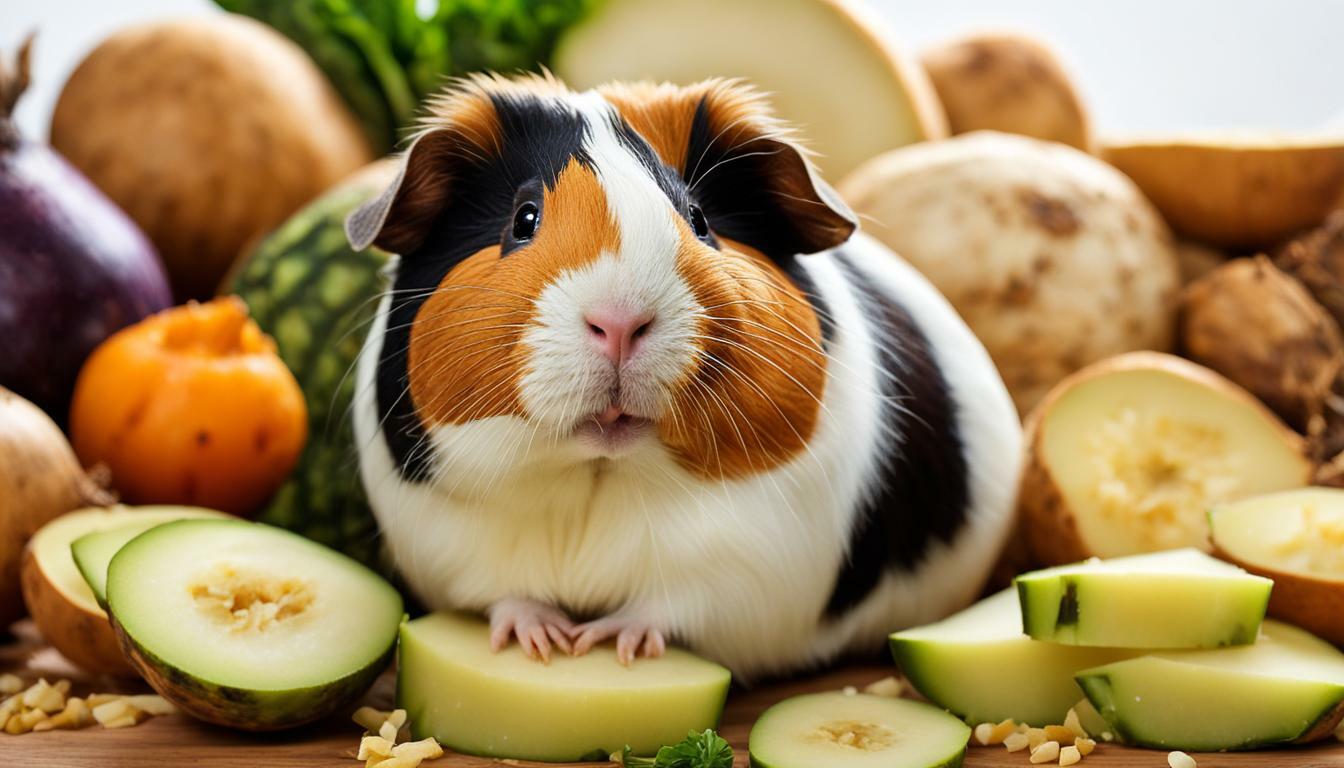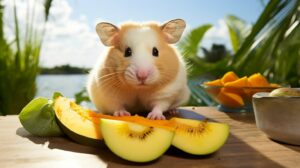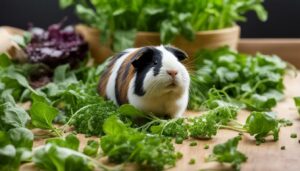If you’re wondering whether guinea pigs can enjoy the subtle sweetness of jicama, we have the answer for you. Guinea pigs can indeed eat jicama, a root vegetable native to Mexico. However, there are a few important things to keep in mind when feeding jicama to your furry friends.
Key Takeaways:
- Jicama is safe for guinea pigs to consume, but should be peeled to remove the potentially toxic skin.
- It is important to cut jicama into small, digestible pieces to avoid any choking hazards.
- Due to its high sugar content, jicama should be fed in moderation and only as an occasional treat.
- Jicama is a good source of vitamin C, which is essential for guinea pigs since they cannot produce their own.
- As with any new food, it’s important to monitor guinea pigs for any digestive issues when introducing jicama into their diet.
Jicama can be a tasty and nutritious addition to your guinea pig’s diet when given in the right amounts and prepared properly. Let’s explore the benefits of jicama, how to prepare it for your guinea pigs, and other safe fruits and vegetables they can enjoy alongside this root vegetable.
Benefits of Jicama for Guinea Pigs
Jicama offers several health benefits for guinea pigs due to its rich nutritional profile. This root vegetable, native to Mexico, is packed with essential nutrients, including vitamin C, fiber, and antioxidants.
Vitamin C is crucial for guinea pigs as they cannot produce it on their own. Jicama can serve as a great source of this essential nutrient, helping to support their immune system and overall health.
In addition to vitamin C, jicama is high in fiber, which aids in digestion and promotes a healthy gut. It can help prevent digestive issues such as constipation and diarrhea, keeping your guinea pig’s digestive system in optimal condition.
Jicama is also rich in antioxidants, which can help protect against oxidative stress and reduce the risk of certain diseases. These antioxidants can support your guinea pig’s overall well-being and contribute to their longevity.
| Nutrient | Amount per 100g |
|---|---|
| Vitamin C | 20.2mg |
| Fiber | 4.9g |
| Antioxidants | High |
Overall, jicama can be a beneficial addition to your guinea pig’s diet. However, it should be fed in moderation and properly prepared. To ensure your guinea pig’s safety, always peel the jicama to remove the potentially toxic skin. Cut it into small, digestible pieces to avoid choking hazards. Due to its high sugar content, jicama should only be given as a treat, once or twice a week. Remember to monitor your guinea pig for any digestive issues when introducing new foods, including jicama. A balanced diet for guinea pigs primarily consists of hay/grass, fresh vegetables, and a small amount of guinea pig pellets. By incorporating jicama into their diet, you can provide your guinea pig with additional nutrients and variety in their meals.
Preparing Jicama for Guinea Pigs
Before offering jicama to your guinea pig, it’s crucial to prepare it correctly to ensure their safety and enjoyment. Jicama is a delicious root vegetable that can be a healthy treat for your furry friend. Here are the steps to properly prepare jicama for your guinea pig:
- Start by choosing a fresh jicama that is firm and free from any soft spots or mold.
- Using a vegetable peeler, remove the tough, outer skin of the jicama. This step is important because the skin of jicama can be toxic to guinea pigs.
- Once you have peeled the jicama, cut it into small, bite-sized pieces. This will make it easier for your guinea pig to chew and digest.
Now that your jicama is properly prepared, you can offer it to your guinea pig as a treat. Remember that jicama should only be given in moderation due to its high sugar content. It’s best to offer a small amount of jicama once or twice a week to avoid any digestive issues.
Safe Fruits and Vegetables for Guinea Pigs
In addition to jicama, there are other safe fruits and vegetables that you can include in your guinea pig’s diet. These include:
- Bell peppers: Rich in vitamin C and low in sugar, bell peppers are a great addition to your guinea pig’s diet.
- Cucumber: High in water content and low in calories, cucumber is a refreshing snack for guinea pigs.
- Kale: Packed with nutrients, kale is a leafy green vegetable that can provide a boost of vitamins and minerals to your guinea pig’s diet.
Remember to introduce new fruits and vegetables gradually to your guinea pig’s diet and monitor for any signs of digestive upset. With proper preparation and moderation, jicama and other safe fruits and vegetables can be a healthy and enjoyable addition to your guinea pig’s diet.
| Fruit/Vegetable | Benefit | Preparation |
|---|---|---|
| Jicama | High in vitamin C, fiber, and antioxidants | Peel and cut into small pieces |
| Bell Peppers | Rich in vitamin C and low in sugar | Remove seeds and chop into small pieces |
| Cucumber | High in water content and low in calories | Peel and slice into thin rounds |
| Kale | Packed with nutrients | Remove tough stems and chop into small pieces |
Moderation and Frequency of Jicama Consumption
While jicama can be a healthy addition to a guinea pig’s diet, it should be given in moderation and as an occasional treat. This delicious root vegetable is packed with essential nutrients, including vitamin C, fiber, and antioxidants. However, guinea pigs should not consume jicama excessively due to its high sugar content.
To incorporate jicama into your guinea pig’s diet, it is important to prepare it properly. Start by peeling off the skin, as the outer layer can be toxic to guinea pigs. Once peeled, cut the jicama into small, bite-sized pieces. This will make it easier for your pet to eat and digest.
When offering jicama to your guinea pig, it is recommended to limit the portions. A small amount, approximately the size of a tablespoon, can be given once or twice a week. This ensures that your furry friend receives the nutritional benefits without consuming excessive sugar.
| Benefit | Quantity | Frequency |
|---|---|---|
| Vitamin C | Small amount | Once or twice a week |
| Fiber | Small amount | Once or twice a week |
| Antioxidants | Small amount | Once or twice a week |
Remember to observe your guinea pig for any digestive issues when introducing jicama or any new food into their diet. Each guinea pig is unique, and some may have more sensitive stomachs than others. If you notice any signs of discomfort, such as diarrhea or bloating, it is best to consult a veterinarian.
While jicama can provide a tasty and nutritious treat for your guinea pig, it should not replace the main components of their diet. A balanced diet for guinea pigs consists primarily of hay/grass, fresh vegetables, and a small amount of guinea pig pellets. Jicama can be included as a supplementary snack, adding variety and enrichment to their diet.
Vitamin C and Guinea Pigs
Guinea pigs are unable to produce their own vitamin C, making it crucial to provide them with foods rich in this essential nutrient, such as jicama. This root vegetable from Mexico is not only safe for guinea pigs to consume but also offers numerous health benefits.
One of the key advantages of jicama is its high vitamin C content. This nutrient is vital for guinea pigs as it helps support their immune system, promotes wound healing, and aids in the production of collagen. Including jicama in their diet can help prevent vitamin C deficiency, a condition known as scurvy, which can cause a range of health issues in guinea pigs.
In addition to vitamin C, jicama also provides guinea pigs with fiber and antioxidants. The fiber content in jicama supports healthy digestion by promoting regular bowel movements. Antioxidants help protect the body’s cells from damage caused by harmful molecules called free radicals, and jicama is rich in these beneficial compounds.
| Jicama’s Nutritional Value for Guinea Pigs |
|---|
| Vitamin C: Supports the immune system and promotes healing |
| Fiber: Aids in digestion and promotes regular bowel movements |
| Antioxidants: Protects cells from damage |
Feeding Jicama to Guinea Pigs
When introducing jicama to guinea pigs, it is important to prepare it properly. The skin of jicama contains potential toxins, so it should be peeled before feeding. Additionally, jicama should be cut into small, bite-sized pieces to facilitate digestion. It is recommended to offer jicama as a treat once or twice a week in small amounts due to its high sugar content.
While jicama is a nutritious addition to a guinea pig’s diet, it should not be the sole source of vitamin C. A balanced diet for guinea pigs consists primarily of hay or grass, fresh vegetables, and a small amount of guinea pig pellets. These food items, along with jicama, can help ensure that guinea pigs receive the necessary nutrients for optimal health and well-being.
Digestive Issues and Jicama Introduction
When introducing jicama or any new food to your guinea pig’s diet, it’s important to observe them for any signs of digestive problems. Guinea pigs have sensitive digestive systems, so it’s crucial to take the necessary precautions to ensure their health and well-being.
Jicama can be a nutritious addition to your guinea pig’s diet, but it should be given in moderation. One of the common digestive issues seen in guinea pigs is diarrhea, which can be caused by sudden changes in their diet or the introduction of new foods. To avoid this, start by offering small amounts of jicama to see how your guinea pig reacts.
When preparing jicama for your guinea pig, it’s crucial to remove the skin. The skin of jicama contains potentially toxic substances that can be harmful to guinea pigs. Make sure to peel the jicama before cutting it into small, digestible pieces. By doing so, you minimize the risk of digestive issues and ensure the safety of your guinea pig.
Table: Jicama Preparation Tips
| Step | Instructions |
|---|---|
| 1 | Wash the jicama thoroughly to remove any dirt or debris. |
| 2 | Use a vegetable peeler to remove the skin of the jicama. |
| 3 | Cut the jicama into small, bite-sized pieces. |
| 4 | Offer a small amount of jicama to your guinea pig and monitor their reaction. |
Remember, jicama should be given as a treat and not as a substitute for a balanced guinea pig diet. Your furry friend’s main diet should consist of hay/grass, fresh vegetables, and a small amount of guinea pig pellets. By providing a varied and balanced diet, you can keep your guinea pig healthy and ensure they receive all the nutrients they need.
A Balanced Diet for Guinea Pigs
A healthy guinea pig diet consists of a variety of components to ensure their overall well-being. Along with a constant supply of hay or grass, fresh vegetables play a crucial role in providing essential nutrients to guinea pigs. These small animals require a diet rich in fiber, vitamin C, and other nutrients to maintain optimal health. While guinea pig pellets can supplement their diet, it is important to include fresh vegetables as a significant part of their daily food intake.
When it comes to vegetables, guinea pigs can enjoy a wide range of options. Leafy greens such as romaine lettuce, kale, and spinach are excellent choices. These vegetables are low in calories and high in vitamins, minerals, and antioxidants. Bell peppers, cucumbers, and carrots are also great additions to their diet. These vegetables not only provide essential nutrients but also help keep guinea pigs hydrated due to their high water content.
| Vegetables | Serving Size | Frequency |
|---|---|---|
| Romaine Lettuce | A handful | Daily |
| Kale | A few leaves | 2-3 times a week |
| Bell Peppers | 1-2 slices | 2-3 times a week |
| Cucumbers | 1-2 slices | 2-3 times a week |
| Carrots | 1-2 baby carrots | 2-3 times a week |
It is essential to introduce new vegetables gradually, allowing guinea pigs to adjust to the change in their diet. This helps prevent digestive issues such as diarrhea or bloating. Additionally, it is important to wash all vegetables thoroughly before serving them to remove any pesticides or dirt that may be present. It is also recommended to remove any uneaten vegetables from their cage after a couple of hours to maintain cleanliness and prevent spoilage.
Variety is key
Offering a variety of vegetables ensures that guinea pigs receive a broad range of nutrients. It is recommended to rotate the types of vegetables given to them to provide a diverse and balanced diet. This helps prevent boredom and allows guinea pigs to enjoy different flavors and textures.
Overall, a balanced diet for guinea pigs should consist of a combination of hay or grass, fresh vegetables, and a small amount of guinea pig pellets. This ensures that they receive the necessary vitamins, minerals, and fiber to support their overall health and well-being. By providing a diverse and nutritious diet, you can help your furry friends thrive.
Introduction to Jicama
Jicama, a delicious root vegetable native to Mexico, is gaining popularity as a potential treat for guinea pigs. With its crispy texture and slightly sweet taste, jicama can provide a refreshing and nutritious addition to your furry friend’s diet. But before you start feeding jicama to your guinea pig, it’s important to understand the benefits and proper preparation techniques to ensure their health and well-being.
The Nutritional Value of Jicama for Guinea Pigs
Jicama is packed with essential nutrients that can benefit guinea pigs. It is particularly rich in vitamin C, which is crucial for their overall health. As guinea pigs cannot produce their own vitamin C, it is essential to provide them with a dietary source to prevent conditions like scurvy. Jicama also offers a good amount of dietary fiber, promoting healthy digestion and preventing gastrointestinal issues. Additionally, it contains antioxidants that help boost their immune system and protect them from cellular damage.
To ensure your guinea pig receives the nutritional benefits, it is important to properly prepare jicama for them.
Preparing Jicama for Guinea Pigs
Before serving jicama to your guinea pig, it’s crucial to remove the potentially toxic skin. Peel the jicama thoroughly and discard the skin. After peeling, cut the jicama into small, bite-sized pieces that are easy for your guinea pig to chew and digest. This will also prevent any choking hazards. Remember, moderation is key when feeding jicama to your guinea pig due to its high sugar content. It is recommended to offer a small amount of jicama as a treat once or twice a week, along with a balanced diet that consists mainly of hay/grass, fresh vegetables, and a small amount of guinea pig pellets.
Conclusion
Jicama can be a safe and nutritious treat for your guinea pig when properly prepared and fed in moderation. Its vitamin C, fiber, and antioxidant content can contribute to their overall well-being. Remember to peel and cut the jicama before serving, and monitor your guinea pig for any digestive issues. As always, consult with a veterinarian before making any significant changes to your guinea pig’s diet to ensure their health and happiness.
| Nutrient | Amount per 100g of Jicama |
|---|---|
| Vitamin C | 20.2mg |
| Fiber | 3.9g |
| Antioxidants | Various types |
Jicama’s Nutritional Value for Guinea Pigs
Jicama boasts an impressive nutritional profile that can provide several health benefits to guinea pigs. This root vegetable is packed with essential nutrients, making it a great addition to their diet.
First and foremost, jicama is a rich source of vitamin C, a crucial nutrient that guinea pigs require in their daily diet. As guinea pigs cannot produce their own vitamin C, they rely on external sources to meet their needs. Jicama can help fulfill this requirement, ensuring optimal health and boosting their immune system.
| Nutrient | Amount per 100g |
|---|---|
| Vitamin C | 20.2mg |
| Fiber | 4.9g |
| Antioxidants | Ambient |
In addition to vitamin C, jicama is also high in fiber, which aids in digestion and promotes a healthy gastrointestinal system for guinea pigs. The fiber content helps regulate bowel movements, prevent constipation, and maintain overall digestive health.
Furthermore, jicama contains antioxidants, which are beneficial substances that protect cells from oxidative damage caused by harmful free radicals. Antioxidants play a crucial role in reducing the risk of diseases and promoting overall well-being in guinea pigs.
Summary:
- Jicama is safe for guinea pigs to consume and can provide several health benefits.
- It is rich in vitamin C, which is essential for guinea pigs as they cannot produce it themselves.
- Jicama is also high in fiber, which promotes a healthy digestive system.
- The antioxidant content in jicama helps protect guinea pigs’ cells from oxidative damage.
When introducing jicama into a guinea pig’s diet, it is important to remember that moderation is key. While jicama is nutritious, it should only be given in small quantities, once or twice a week, due to its high sugar content. Additionally, always ensure that the jicama is properly peeled and cut into small, digestible pieces before serving it to your guinea pig. By following these guidelines, you can provide your furry friend with a varied and healthy diet that includes the nutritional benefits of jicama.
Other Safe Fruits and Vegetables for Guinea Pigs
While jicama can be a great addition to a guinea pig’s diet, there are several other fruits and vegetables that are also safe and nutritious for them. These options can provide variety and additional vitamins and minerals to support their overall health.
Safe Fruits for Guinea Pigs
Guinea pigs can enjoy a variety of fruits as occasional treats. It’s important to remember that fruits contain natural sugars, so they should be given in small amounts. Some safe fruits for guinea pigs include:
- Apples: Remove the seeds and core, and offer small slices.
- Strawberries: Remove the green tops and offer whole or sliced.
- Blueberries: Offer a few at a time as a tasty snack.
- Watermelon: Remove the seeds and rind, and offer small cubes.
Safe Vegetables for Guinea Pigs
Vegetables are an essential part of a guinea pig’s diet, providing important nutrients and keeping their digestive system healthy. Here are some safe vegetables that guinea pigs can enjoy:
- Bell Peppers: Offer sliced bell peppers in different colors for added variety.
- Cucumbers: Slice cucumbers into thin rounds for a refreshing snack.
- Romaine Lettuce: Tear the leaves into small pieces for easier eating.
- Cilantro: This herb can be a flavorful addition to their diet.
Remember to introduce new fruits and vegetables gradually to prevent any digestive upset. Always wash and prepare them properly, removing any seeds, pits, or toxic parts. Additionally, it’s best to consult with a veterinarian to ensure that the chosen fruits and vegetables are suitable for your guinea pig’s specific dietary needs.
| Fruits | Benefits |
|---|---|
| Apples | High in vitamin C and fiber |
| Strawberries | Rich in vitamin C and antioxidants |
| Blueberries | Contains antioxidants and vitamins |
| Watermelon | Hydrating and a good source of vitamin C |
Conclusion
In conclusion, guinea pigs can safely enjoy jicama as part of a balanced diet, but moderation and proper preparation are key.
Jicama, a root vegetable native to Mexico, is a nutritious addition to a guinea pig’s diet. It is rich in essential nutrients such as vitamin C, fiber, and antioxidants, which can support their overall health and well-being.
However, before feeding jicama to guinea pigs, it is important to peel the vegetable to remove the potentially toxic skin. Additionally, cutting the jicama into small, digestible pieces will make it easier for them to consume and avoid any potential choking hazards.
Due to its high sugar content, jicama should be given to guinea pigs in moderation. Offering a small amount once or twice a week as a treat is sufficient to provide them with the benefits of this root vegetable without overloading their diet with excessive sugar intake.
Remember, while jicama can be a valuable addition to a guinea pig’s diet, it should not replace the main components of their diet. A balanced diet for guinea pigs should primarily consist of hay/grass, fresh vegetables, and a small amount of guinea pig pellets to ensure they receive all the necessary nutrients for optimal health.
FAQ
Can guinea pigs eat jicama?
Yes, guinea pigs can eat jicama in moderation and when properly prepared.
What are the benefits of jicama for guinea pigs?
Jicama is loaded with vitamin C, fiber, and antioxidants, which are beneficial for guinea pigs’ overall health.
How should jicama be prepared for guinea pigs?
Jicama should be peeled and cut into small pieces for easier digestion.
How often should guinea pigs eat jicama?
Jicama should be given in small amounts once or twice a week due to its high sugar content.
Is jicama a good source of vitamin C for guinea pigs?
Yes, jicama can provide guinea pigs with essential vitamin C, as they cannot produce it on their own.
Should guinea pigs be monitored for digestive issues when introducing jicama?
Yes, it is important to monitor guinea pigs for any digestive issues when introducing new foods, including jicama, into their diet.
What should be included in a balanced diet for guinea pigs?
A balanced diet for guinea pigs consists mainly of hay/grass, fresh vegetables, and a small amount of guinea pig pellets.
What is jicama and where does it come from?
Jicama is a root vegetable native to Mexico, known for its crisp texture and slightly sweet taste.
What is the nutritional value of jicama for guinea pigs?
Jicama is rich in vitamin C, fiber, and antioxidants, making it a nutritious addition to a guinea pig’s diet.
Are there other safe fruits and vegetables for guinea pigs?
Yes, there are many other fruits and vegetables that guinea pigs can enjoy in addition to jicama.




